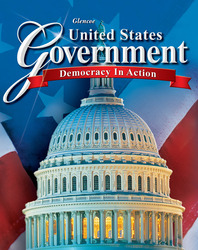
United States Government: Democracy in ActionChapter 1: People and GovernmentChapter Overviews[logo] Essential Question Section 1 Principles of Government Scholars have constructed theories to explain the origins of the state. The evolutionary theory surmises that the state evolved from the family. The force theory cites forced cooperation to resist an enemy as the reason for the emergence of states. Some states emerged because their rulers claimed leadership as descendents of gods—the divine right theory. In contrast, the social contract theory emphasizes an agreement in which rulers promise to preserve the natural rights of the people who elected them to power. Modern governments have several functions: to maintain social order, to provide public services, to provide security and defense, and to provide for the economy. To fulfill these functions, governments make rules that everyone must follow. Section 2 The Formation of Governments The effort to control or influence the conduct of government is called politics. People take part in politics when they demonstrate for a cause or meet with elected leaders for benefits. Politics provides a peaceful way for people to come up with compromises. The world includes industrialized nations and developing nations. Although they differ in their amounts of industry and technology, they are still interdependent. Trade and the Internet link nations' economies. Other global connectors include multinational corporations, national organizations such as the United Nations, nongovernmental organizations such as Doctors Without Borders, and even terrorist groups. Section 3 Types of Government A true democracy has certain key characteristics: individual liberty, majority rule with minority rights, free elections, and competing political parties. Rival parties make elections meaningful because they give voters a choice. To sustain a democracy, five elements are essential. These include citizen participation, a favorable economy, widespread education, a strong civil society with a network of voluntary groups, and a social consensus in accepting liberty and equality for all. Section 4 Economic Theories Capitalism is a free market economic system in which freedom of choice and individual incentives for workers, investors, consumers, and businesses are emphasized. Competition among buyers and sellers plays a key role. The American economy is one of the most capitalistic, although it does have significant government regulation. Socialism is an economic system in which the government controls the basic means of production; distributes products and wages; and provides social services such as education, health care, and welfare. Democratic socialist countries have democratic rights, but the government owns key large industries and makes economic decisions to benefit everyone. Communism was developed by Karl Marx, who predicted that capitalism would collapse and be replaced by one class—the working class. All property would be held in common, and there would be no need for a government. In communist countries with command economies, all economic decisions are made at the upper levels of government and handed down to managers. The government owns the land, resources, industry, banks, and transportation. It also controls newspapers, television, the Internet, and the movie industry. Today only a handful of communist states exist in the world. |  |















